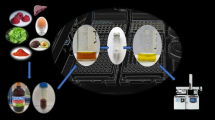Abstract
A low-cost laboratory extractor has been designed and constructed that selectively extracts polar and nonpolar components from oilseeds and other matrices. The extractor uses available high-performance liquid chromatography laboratory equipment for pumping the solvent into the extractor. Pressure, temperature, and valving arrangements are automatically controlled by commercially available components. Advantages of this system include low initial investment, reduced solvent consumption, shorter extraction times, quantitative lipid recovery, use of multiple extraction solvents, and reduction in cost per sample. The method has broader applications that include extraction of trace components from a variety of matrices, for example, the extraction of pesticides from foods and polychlorobiphenyls from soil. Class separation of components from different matrices can be achieved easily by selection of solvents with the appropriate polarity characteristics. Very small samples can be extracted simply by changing cell size or by adding an inert material to the cell to fill the void volume. Analyte collection can be accomplished by collecting in a test tube with an appropriate solvent, or on a solid-phase material. Optimization of extraction times, number of extractions, matrices, and solvent used is described. Neutral lipids were extracted from peanut meal in 70 min by the rapid extraction method compared to 1440 min required to extract the comparable amount of neutral lipids from a similar sample by the Soxhlet extraction method.
Similar content being viewed by others
References
Herslof, B. G., Analysis of Industrial Phospholipids Materials, in Phospholipids: Characterization, Metabolism, and Novel Applications, edited by G. Cevc and F. Paltauf, AOCS Press, Champaign, 1995, pp. 1–14.
Gunnlaugsdottir, H., and R.G. Ackman, Three Extraction Methods for Determination of Lipids in Fish Meal: Evaluation of a Hexane/Isopropanol Method as a Alternative to Chloroform-Based Methods, J. Sci. Food Agric. 61:235–240 (1993).
Radin, N.S., Extraction of Tissue Lipids with a Solvent of Low Toxicity, in Methods in Enzymology, edited by J. Lowenstein, Academic Press, New York, 1981, pp. 5–7.
Nelson, C.G., Isolation and Purification of Lipids from Biological Matrices, in Analyses of Fats, Oils, and Lipoproteins, edited by E.G. Perkins, American Oil Chemists’ Society, Champaign, 1991, pp. 20–59.
List, G.R., and J.P. Friedrich, Oxidative Stability of Seed Oils Extracted with Supercritical Carbon Dioxide, J. Am. Oil Chem. Soc. 66:98–100 (1989).
Calvo, L., M.J. Cocero, and J.M. Diez, Oxidative Stability of Sunflower Oil Extracted with Supercritical Carbon Dioxide, Ibid.:1251–1254 (1994).
Ganzler, K., A. Salgo, and K. Valko, Microwave Extraction: A Novel Sample Preparation Method for Chromatography, J. Chromatogr. 371:299–306 (1986).
Chen, S.-S., and M. Spiro, Kinetics of Microwave Extraction of Rosemary Leaves in Hexane, Ethanol and a Hexane + Ethanol Mixture, J. Flavor Frag. 10:101–112 (1995).
Later, D.W., B.E. Richter, and J.L. Ezzell, An Accelerated Solvent Extraction System for the Rapid Preparation of Environmental Organic Compounds in Soil, Amer. Lab. 27:24–28 (1995).
Ezzell, J.L., B.E. Richter, W.D. Felix, S.R. Black, and J.E. Meikle, A Comparison of Accelerated Solvent Extraction with Conventional Solvent Extraction for Organophosphorus Pesticides and Herbicides, LC-GC 13:390–398 (1995).
Singleton, J. A., and H.E. Pattee, Computation of Conversion Factors to Determine the Phospholipid Content in Peanut Oil, J. Am. Oil Chem. Soc. 58:873–875 (1981).
Singleton, J.A., and L.F. Stikeleather, High-Performance Liquid Chromatography Analysis of Peanut Phospholipids. I. Injection System for Simultaneous Concentration and Separation of Phospholipids, Ibid.:481–483 (1995).
Singleton, J.A., and L.F. Stikeleather, High-Performance Liquid Chromatography Analysis of Peanut Phospholipids. II. Effect of Post Harvest Stress on Phospholipid Composition, Ibid.:485–488 (1995).
Singleton, J.A., and L.F. Stikeleather, U.S. Patent Number 5,462,660 (1995).
Mounts, T.L., and A.M. Nash, HPLC Analysis of Phospholipids in Crude Oil for Evaluation Soybean Deterioration, J. Am. Oil Chem. Soc. 67:757–760 (1990).
Author information
Authors and Affiliations
Corresponding author
About this article
Cite this article
Singleton, J.A., Stikeleather, L.F. A solvent extractor system for the rapid extraction of lipids and trace bioactive micronutrients in oilseeds. J Amer Oil Chem Soc 76, 1461–1466 (1999). https://doi.org/10.1007/s11746-999-0185-1
Received:
Accepted:
Issue Date:
DOI: https://doi.org/10.1007/s11746-999-0185-1




